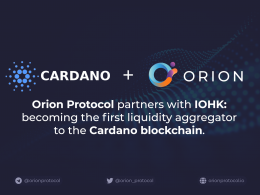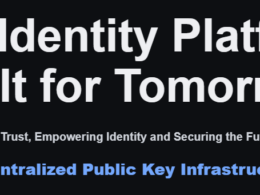Milkomeda is a novel protocol that powers several leading blockchains (Algorand, Terra, Solana, Cardano), to interconnect, creating a path for long-term scaling.
Focused on helping non-EVM (Ethereum Virtual Machine) cryptocurrencies to achieve and maintain mass adoption, Milkomeda will empower them with EVM-based sidechains, and novel technology that provides a seamless user experience for both developers and users. in general.
The Ethereum Virtual Machine is a Turing complete virtual machine, which makes the Ethereum blockchain work possible, processing transactions and smart contracts with programming in Solidity.
Charles Hoskinson, CEO of IOHK, stated: “[…] Interoperability is crucial to mainstream blockchain adoption; At IOHK, we don’t believe there is ‘one blockchain to rule them all’ and instead value collaboration. When it comes to interoperability and scalability, sidechains are an essential part of our vision for Cardano […].”
The latest generation of blockchains (Cardano, Solana, Polkadot, etc.) approach scalability in their own way and with their own designs, however the developer community is limited to each ecosystem, so interaction is required to allow wider adoption.
The Milkomeda protocol proposes several sidechains, which will allow developers to write smart contracts in the languages they are familiar with, for example Solidity, and deploy them on multiple chains. Which means they don’t have to learn the functional programming languages of Haskel and Plutus to build on top of Cardano, thus lowering the barrier to entry for developers, and increasing their number on Cardano.
Milkomeda will be implemented on Cardano first, bringing EVM support to the ecosystem, as initially envisioned in the Cardano roadmap.
Future Milkomeda deployments will also open the doors to interoperability between Cardano, Solana, and other L1 blockchains. In this way, Milkomeda will work to achieve both the sidechain vision and the multi-blockchain interoperability vision.
For this reason, and alluding to that interoperability, the name “Milkomeda” derives from the merger of the Milky Way and Andromeda galaxies, uniting universes.
Sidechains as Blockchain Bridges
Milkomeda’s sidechain will enable the transfer of projects from one blockchain to another, by creating sidechains with alternative virtual machines, connected to the main L1 chains, that use their cryptocurrency as their base asset, exposing these projects to another group of users and thus increasing the exposure of a project.
Users holding tokens on the connected chain can move these assets to Cardano, and vice versa, simply by wrapping them on the sidechain that links the two blockchains. Once wrapped, these tokens become native assets on the Cardano mainnet and function the same as native assets on Cardano.
In other words, as an example for Cardano, Milkomeda will allow sidechains to be implemented that connect directly to the mainchain and use wADA (wrapped ADA) as the asset to pay transaction fees. As such, a new piece of technology, wrapped smart contracts, will be developed and implemented in the protocol.
With smart contracts wrapped up, the L1 blockchain becomes a strong coordination layer, where users stay, while executing smart contracts on the sidechain without having to move to the sidechain. This brings a novel user experience to the table for end users, where, for example, they will have the power to run smart contracts on an EVM sidechain directly from the Cardano mainnet (just like any other L1 implementation) without having to switch wallets or even not knowing what’s going on behind the scenes.
A DApp, or anyone, can deploy a smart contract on the sidechain from the connected virtual machine or from the blockchain. This makes the smart contract available to Cardano users who can then interact with it via the sidechain. This means that Cardano users can seamlessly use smart contracts that are based on other chains and written in coding languages other than Plutus.
Wrapped smart contracts open up the smart contracting capabilities of chains that do not use the Solidity programming language, for example, Cardano, Algorand, Solana, and Terra, to Solidity developers. Thus increasing the group of developers capable of programming in these chains.
Smart contracts only need to be implemented once, which means they don’t need to be recoded into other languages to work on other chains. So there is less code and fewer vulnerabilities for hackers to exploit.
Milkomeda C1
Milkomeda’s first sidechain is called C1, directly connected to Cardano and based on EVM. Milkomeda C1 sidechain is also affectionately known as “Milkodano”.
It appears that it will also be the first Cardano sidechain.
This sidechain will open up the Cardano ecosystem to developers of the most popular smart contract language, Solidity.
The native currency of this sidechain will be MilkADA, with which fees will be paid for using the sidechain.
While allowing for the ability to inter-blockchain and transfer projects from one chain to another, these sidechains are built on top of Cardano and will use wrapped ADA, MilkADA, as their native currency.
Transactions executed on the sidechain will pay MilkADA fees. These sidechains are run by validators, which will initially be made up of a small group of Cardano stakepool operators. Ultimately, the governance of these sidechains will take place through a DAO running on the Cardano mainnet.
The total amount of ADA delegated will remain in that condition in the stakepool, when wrapped to be transferred to the C1 sidechain until the next epoch boundary, which means that the sidechain works in synergy with the Cardano mainnet.
Users interact with smart contracts located on the sidechain without leaving the main Cardano network. The user creates a transaction with their assets, as they normally would, and sends it to the network. These assets are transferred to the sidechain where they interact with the DApp. The results of the transaction are then deposited into the user’s wallet on the Cardano mainnet. All of this happens under the hood, creating a friendly user experience.
Governance
Sidechains will be governed by their users on Cardano through the Milkomeda DAO, and to participate, users must use the Cardano blockchain. Users will be incentivized to vote through rewards.
They will be able to vote on a variety of network parameters and, more importantly, on the addition and removal of validators. Aspects managed by the DAO include:
- Adding or removing validators
- Launching new sidechains
- Reducing or increasing required collateral amounts
- Punishing malicious validators
- Spending treasury funds to fund the growth of existing sidechain ecosystems
- Deciding which stake groups the wrapped ADA is delegated to
- Accepting tokens on the sidechain (by adding them to the sidechain token registry)
- Verifying and accepting new wrapped contracts (after developer audit)
Validators
Validators are the producers of blocks for the sidechain and will be added and be removed by votes made on the Milkomeda DAO, executed on Cardano. The list of validators will be stored on the Cardano mainnet. The initial validators will be a carefully selected subset of the existing operators on Cardano. Validators will be required to provide collateral to become sidechain validators. If they are found to be bad actors, this guarantee is cut.
Validators will also be tasked with running the sidechain bridge, which is what enables the transfer of assets and the request of smart contracts by users.
Validators will be paid weekly from the treasury. Their payments will be placed in smart contracts and locked for two weeks.
The Developer Company: dcSpark
The developer company is dcSpark, a company that creates products and solutions for cryptographic projects.
The founding partners worked at Emurgo, specifically leading the development of the Yoroi wallet and the Cardano serialization library. They are currently building promising crypto projects:
Product 1: Flint (Multichain) Plutus is around the corner and users will need software to interact with all of the smart contracts available straight from the web browser.
Product 2: Milkomeda (Multichain)
Product 3 Urbit will streamline the process of creating off-chain p2p web apps.
The company was founded by Sebastien Guillemot, Nicolas Arqueros and Robert Kornacki.
Sebastien Guillemot
After working at Microsoft, he joined EMURGO (Cardano’s Consensys) as VP of Engineering and Product Manager at Cardano, where his team built products that reached 6-digit active user numbers, and led the development of SDKs used by large companies such as Coinbase.
Nicolas Arqueros
He has experience in both founding and mentoring many successful startups during his career. He was previously the CTO of EMURGO (Cardano’s Consensys) and is currently a member of the Board of Directors of the Cardano Foundation and Senior Investment Advisor at SOSV.
Robert Kornacki
Started as a fellow at dLab (blockchain accelerator program) and later joined Ergo Foundation as a board member, as well as EMURGO (Cardano’s Consensys) as Head of Research, where he developed design patterns and smart contracts that manage millions of assets.
You can see the full team here.
The developers have presented proposals in Catalyst related to the protocol. I have published 3 of them in Ada Pulse, funded in Fund 6:










